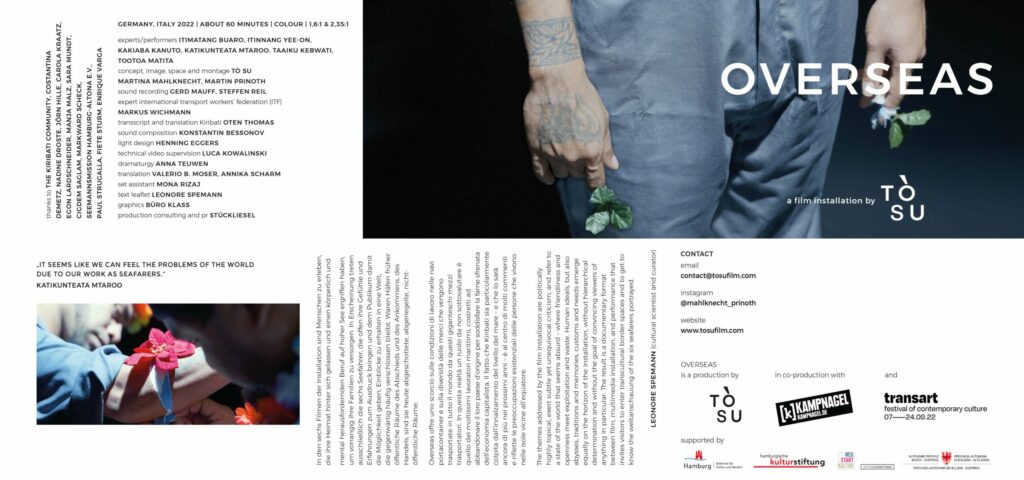
OVERSEAS
multi channel film installation | Germany | about 60 minutes | colour | 4k & HD / stereo
in Kiribati with optionally German, Italian or English subtitles
During the Covid 19 pandemic, numerous sailors from the Pacific island state of Kiribati were stranded in the port of Hamburg. In an unlikely collaboration, the German-Italian artist duo TÒ SU worked with them to develop the immersive film installation OVERSEAS. In a flooded stage space the audience is immersed in the seafarers’ stories of longing and separation, money and recognition, pride an community, environmental and climate risks. Using documentary-performative means, the artists make inside views of the global movement of goods and its vulnerability visible and tangible. OVERSEAS is the first part of a trilogy about the realities of life and working conditions on the high seas.
© Fotos: TÒ SU
Mehrkanal Filminstallation | Deutschland | ca. 60 Min. | Farbe | 4k & HD | Stereo
auf Kiribati mit wahlweise deutschen, italienischen oder englischen Untertiteln
Während der Covid-19-Pandemie saßen zahlreiche Seeleute aus dem pazifischen Inselstaat Kiribati im Hafen von Hamburg fest. In einer unwahrscheinlichen Kollaboration entwickelte das deutsch italienische Künstler*innenduo TÒ SU gemeinsam mit sechs der Seeleute die immersive Filminstallation OVERSEAS. In einem gefluteten Bühnenraum tauchen die Zuschauer*innen ein in die Gespräche der Seeleute über Sehnsucht und Trennung, Geld und Anerkennung, Stolz und Gemeinschaft, Umwelt- und Klimarisiken. Mit dokumentarisch-performativen Mitteln machen die Künstler*innen Innenansichten des globalen Warenverkehrs und seine Verwundbarkeit sicht- und spürbar. OVERSEAS ist der erste Teil einer Trilogie über Lebensrealitäten und Arbeitsbedingungen auf Hoher See.
Installazione cinematografica multicanale | Germania | circa 60 minuti | Colore | 4K e HD | Stereo
in Kiribati con sottotitoli in tedesco, italiano o inglese
Durante la pandemia di Covid-19, numerosi marittimi provenienti dallo stato insulare di Kiribati nel Pacifico sono rimasti bloccati nel porto di Amburgo. In un’improbabile collaborazione, il duo artistico italo-tedesco TÒ SU ha sviluppato l’installazione cinematografica immersiva OVERSEAS insieme a sei marinai. In uno spazio allagato, il pubblico è immerso nelle conversazioni dei marinai su desiderio e separazione, denaro e riconoscimento, orgoglio e comunità, rischi ambientali e climatici. Utilizzando mezzi documentario-performativi, gli artisti rendono visibili e tangibili visioni interiori del movimento globale delle merci e della sua vulnerabilità. OVERSEAS è la prima parte di una trilogia sulla realtà della vita e delle condizioni di lavoro in alto mare.
Shown at
Season opening 2022/23 Kampnagel Hamburg, Germany
Transart Festival 22 NOI Techpark Bolzano/Bozen, Italy
MARKK Museum am Rothenbaum Kulturen und Künste der Welt, Germany 20.7. – 20.09.2023
Credits
Expert*innen/Performer*innen Itimatang Buaro, Itinnang Yee-On, Kakiaba Kanuto, Katikunteata Mtaroo, Taaiku Kebwati, Tootoa Matita
Konzept, Bild, Raum, Schnitt TÒ SU Martina Mahlknecht, Martin Prinoth
Experte Internationale Transportarbeit Markus Wichmann
Transkription und Übersetzung Kiribati Oten Thomas
Musik Konstantin Bessonov
Voice Over Annika Scharm
Ton Gerd Mauff, Steffen Reil
Technische Supervision Luca Kowalinski
Licht Henning Eggers
Assistentin Ausstattung Dreh Mona Rizaj
Dramaturgische Beratung Anna Teuwen
Grafik Büro Klass
Übersetzungen Annika Scharm, Valerio B. Moser
Produktionsberatung & Presse- und Öffentlichkeitsarbeit Stückliesel
Danke an die Kiribati Community, Seemannsmission Hamburg, Fiete Sturm, Carola Kraatz, Jörn Hille, Hamburger Kreativgesellschaft, Wartenau 16, Enrique Vargas, Sara Mundt, Markward Scheck, Paul Strugalla, Cigdem Saglam, Manja Malz, Metropolis Kino
Supporters
OVERSEAS ist eine Produktion von TÒ SU in Koproduktion mit Kampnagel Hamburg und dem transart Festival Bolzano/Bozen.
© Fotos: Juha Hansen
TRAILER
TEXT BY LEONORE SPEMANN
cultural scientist and curator
What happens when the TÒ SU duo meets a group of seafarers from Kiribati by chance at the port of Hamburg during the pandemic? Research reasons had brought Martina Mahlknecht and Martin Prinoth to the port. The encounter with the group of stranded men led to the joint project Overseas.
In the six films created, which can be accessed via QR codes on mobile devices in the first part of the installation, seafarers appear on the screen who have left their homeland behind and taken up a physically and mentally challenging profession on the high seas, primarily to provide for their families.
Silence is as much a part of the conversation as thoughts that are spoken and shared. The reflection of the water of the flooded room is mirrored on the uniformed bodies and faces of the sailors. The audible splashing of this water together with the darkened background lends the scene something insistent.
The mutual greeting and introduction of the invitees is marked by the utmost respect and kindness. The appreciation for one another and the mischievous, shifting glances between those sitting in the circle of chairs create a palpable warmth that makes the familiarity and strong cohesion which has developed in times of crisis and the precarious situation on board tangible. In part, the gratitude for each other also comes up in conversation. The idea of having to survive the time ashore without each other, alone, isolated, seems unthinkable.
Previous experiences at sea are also shared. They show that some of the six seafarers already look back on several years at sea and many memories, while others, younger participants in the discussion group, are still at the beginning of their careers as seafarers.
The conversation provides insights into the work on the freighters and the variety of goods that are transported around the globe on large container ships. There is a sense of pride in the statements, which is entirely justified in view of the fact that a large proportion of goods are now transported over long distances in order to be offered and sold worldwide in the commercial sphere. The countless seafarers of this world, who (have to) tear themselves away from their own homeland in order to provide financially for their own families and to satisfy the unbridled hunger of the capitalist economy, have a share in this that should not be underestimated.
The pandemic, with its lockdowns and travel restrictions, has left ships unable to leave and inevitably stranded along with their crews. Some of the five films resonate with a sadness that is hard to escape. What is striking is that despite the continuing difficult situation of the seafarers, no anger, hatred and no indignation come through. This is impressive to experience and marks a difference in the way restrictions on freedom are dealt with which was often not the case locally.
The fact that Kiribati is particularly affected by rising sea levels and will be much more so is the subject of several statements and illustrates the existential concerns that shape the lives of the people who live on the islands near the equator. Without explicitly naming it, the poignant narratives can be understood as an appeal to vehemently do something to counter the advancing climate and environmental crisis.
Only the six seafarers appear, openly expressing their feelings and idiosyncrasies, and thus giving viewers the opportunity to gain insights into a world that often remains closed at present. Whereas ports used to be public spaces of farewell and arrival, of trade, today they are closed off, sealed off, non-public spaces that conceal adverse poor working conditions and other questionable processes.
The themes addressed by the two-part installation are politically highly topical, exert subtle yet unequivocal criticism, and refer to a state of the world that seems absurd – where friendliness and openness meet exploitation and waste. Human ideals, but also abysses, traditions and memories, customs and needs emerge equally on the horizon of the installation, without hierarchical determination and without the goal of convincing viewers of anything in particular.
The result is a documentary format between film, multimedia installation, and performance that invites visitors to enter transcultural border spaces and to get to know the weltanschauung of the six seafarers portrayed. Together with the second part of the installation, the result is an atmospheric experience that defies a simplistic art-theoretical classification. In the second part is a large screen showing the sailors dressing, adorning themselves, and dancing together. The dance was also shot in the same setting, the flooded room. The dance was performed without music, but the rhythmic sound of the dancers’ simultaneous movements in the water, breathing and hand movements can be heard through loudspeakers in the exhibition space.
As the first part of a trilogy, Overseas focuses on the realities of life and working conditions on the high seas. In the following two parts, among other things, the working conditions of the crew of cruise ships are highlighted. The trilogy of the duo TÒ SU is an impressive work of the search for a new view beyond Eurocentric perspectives.
LEAFLET

© Fotos: Luca Guadagnini





























